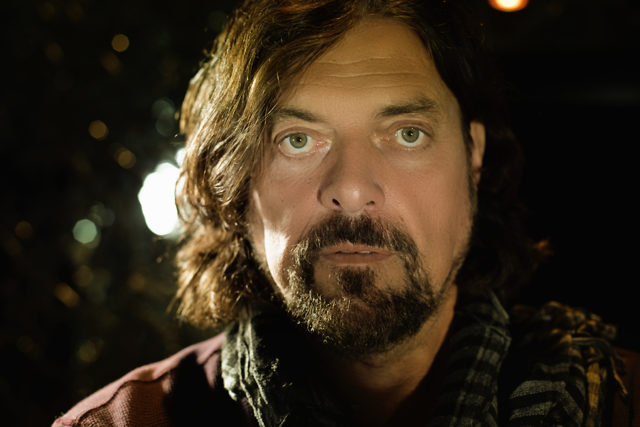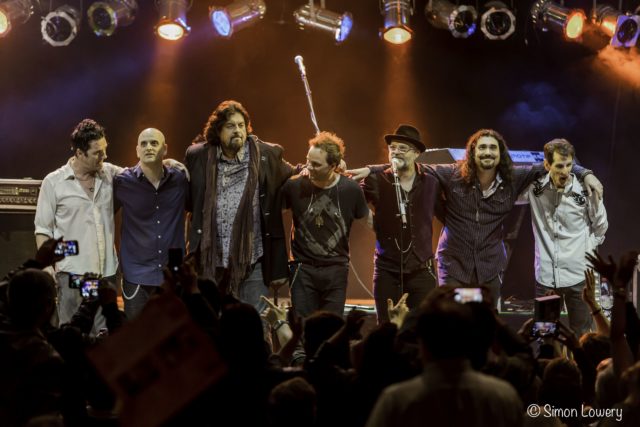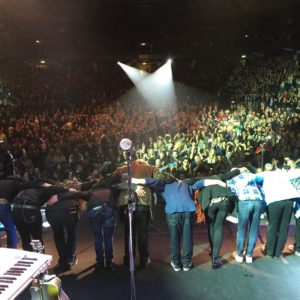
Alan Parsons has always had show business in his blood. Part of it came from his mother, an actress, professional folksinger and harpist. Some of it came from his father, Denys Parsons, an accomplished pianist and flautist as well as the author of several books. His great grandfather was a famous actor/manager, Sir Herbert Beerbohm Tree. Finally, one of his cousins was the celebrated actor Oliver Reed, one of the most popular and significant English actors in the 1960’s through the 1980’s.
Alan started out as a guitarist in the late ’60s, but once he landed a job at London’s famed Abbey Road studios, his performance career was put on hold. Instead, at age 19, Alan began to learn the rudiments of sound recording. This was a move which was not only going to dominate his career, but also to play a role in the recordings of such major acts as The Beatles, the Hollies, Pink Floyd, Al Stewart and Ambrosia. These days, the author of The Art and Science of Sound Recording, one of the most comprehensive and interesting books available on the subject, still takes an active role in producing and engineering music sessions.
I spoke with Alan Parsons and he explained how the circle has since come around to where he is performing and currently on tour. For Alan, life as a producer and engineer was only the start, with many popular albums and several mega-hits that Alan has conceived and produced over the years.
Q: You are currently touring with your most recent band……..
We’re now eight pieces, we just added another guitarist and singer called Dan Tracey. We make a lot of noise!
Q: What do you have in store for the people who will be seeing you on your current European tour?
A: We essentially do a similar show from one city to the next. In America in particular we have a pretty closely-knit formula. It’s the hits, that is what people want to hear; the songs that they would have hopefully grown up with on radio, the most popular songs. We have a really good sound guy which I’m very pleased about of course because I can’t do two jobs at once, I can’t be on the on the stage and mixing as well. We have a great lighting designer as well. It’s a fun show! It’s a visual spectacle as well as an audio spectacle.

Q: You obviously love performing live. What kind of feeling is that, to be up on the stage as opposed to doing anything else?
It’s something I’d never thought I’d do. The Alan Parsons Project was designed and was destined to be only a record making outfit. It was only in the mid-90’s when Ian Bairnson, the guitar player and Stuart Elliott, the drummer and Andrew Powell, the orchestral arranger; after we’d made an album as alan Parsons, not as the Alan Parsons Project—Eric was off doing other things at the time—-it was only at that point that we decided that we could actually put a band together and play live.
I’ve enjoyed it enormously, it is something I really hadn’t anticipated at the time we’d made the records. The Alan Parsons Project had finished by the time we hit the road. Gaudi was the last album and Eric and I never performed together, in his later years he became more interested in musical theatre, while I was still into making rock music, so that’s what I did. We went out with that band to support the album we’d just made, it was called Try Anything Once and we combined the songs from Try Anything Once with the catalog from the Alan Parsons Project and it went down really well.
Our first tour was in Germany and it went down well, so I’ve been enjoying it ever since. It’s a different experience, I’m still the boss, I’m still directing people like I do in the studio, but playing live just has that immediacy. Each moment only comes and passes and you can’t change it. You get one chance to get it right. Whereas in the studio you just keep rewinding and re-recording—you don’t have that luxury on the stage.
Q: You have a new book, Art and Science of Sound Recording. What does it have to offer, not only for someone starting out, but for those established in sound recording careers…..
I’m extremely hopeful that it appeals to a range of audiences outside the industry. Sound recording has always had a mystery to it and I think as well as being essentially instructional to those coming into the industry and those already in the industry, I think it’s entertaining enough to appeal to anybody who has any kind of interest in recording. I think we did attempt, both in the DVD series, which the book is a companion to, we did attempt to lift the veil on the mysteries of recording and give it a general appeal. Having said that, it’s hugely popular in schools, universities with sound recording courses—that seems to be our principal market, but it’s there for everybody.
Q: Tales of Mystery and Imagination was one of the most brilliantly done albums ever conceived. How did it come about?
It all started with my songwriting partner Eric Woolfson coming to me in my early days as a producer. I’d already had some success with the likes of Pilot, John Miles, Al Stewart and so on. He just came up with the idea that together we could make a concept album based on the works of Edgar Allan Poe. He already had a couple of songs up his sleeve for the album. We approached the head of the record label at the time at 20th Century Records, that was Russ Regan . I had already had an association with 20th Century, that was with Ambrosia because I’d mixed their first album.
We went to the big music meeting/convention in Cannes (MIDEM) and he signed us up based on a blank piece of paper and a blank tape. We hadn’t given him any demos or anything, we just gave him the idea and he went for it. We didn’t know at the time that it was going to be called the Alan Parsons Project. The identity of the Alan Parsons Project didn’t come until we’d finished. Russ Regan just came up with that. The guys at the record label had been talking about the album and saying, ‘how’s the Alan Parsons project coming?’. That name just ended up sticking! We didn’t think of it as any particular identity, it was just various artists just produced by alan Parsons. We didn’t realize it would become the name of an act.
Q: I, Robot is a classic for both you and Issac Asimov. Asimov said he really liked it. Did you actually meet him?
I didn’t. Eric apparently had a phone conversation but I don’t think they met face-to-face. Asimov said that He’d love to get involved but that he’d already signed away the rights to others. I see it took a long time to come, that was the Will Smith movie that came out about ten years ago now. It would have been nice to have been asked to get involved in that but having seen the movie I’m glad I didn’t. They distorted it way beyond belief, there was no real clinging to the book at all.
 Q: Did you ever imagine Sirius would receive the recognition and popularity that it has?
Q: Did you ever imagine Sirius would receive the recognition and popularity that it has?
Of course, it was simply an instrumental link to open the Eye In the Sky album; it was the intro to Eye in the Sky. I knew nothing about the Chicago Bulls, it was some years before I knew that they were even using it. Since then, of course, it’s been used by countless sports teams, most notably the New Orleans Saints when they walked on for the Superbowl. I’m obviously very pleased and I’m pleased to say that I earned a bit of money from that! Not from sports games, but from sync licenses on movies and commercials and such. That’s pretty nice!It’s arguably the most high-profile thing we ever did. Even though people don’t actually know it’s me. People tend to refer to it as the Chicago Bulls theme and not mention my name.
It’s funny, you know…..I’m pretty sure I can see on people’s faces in shows that they all know the song but that they didn’t know it was the Alan Parsons Project. Someone will ask me, ‘Oh wow! Was that the Alan Parsons Project? I didn’t know that!”.
(Update: Alan has broadened his current european tour and will will be performing two concerts in Israel and seven concerts in The Netherlands)
From his first assistant engineering jobs on the Beatles’ Abbey Road through an illustrious career as an engineer and producer and composer, Alan Parsons has influenced the music business in a big way. For those who want to enjoy the multitude of songs that he has written, any of his shows provide an excellent chance to enjoy his music. And for those who enjoy his music and want to delve into the creative process of recording, either just as a fan or with an idea of learning from a master what it takes to start or enhance a career in sound recording, the Art and Science of Sound Recording is an excellent way to start. Both for the fun anecdotes about what goes on in the studio and for the immense amount of material, the Art and Science of Sound Recording is an invaluable book for those interested in the creative processes behind the music.
Alan Parson’s website: www.alanparsonsmusic.com
Art and Science of Sound Recording: DVD’s, NetStreaming, media, educational materials and more











